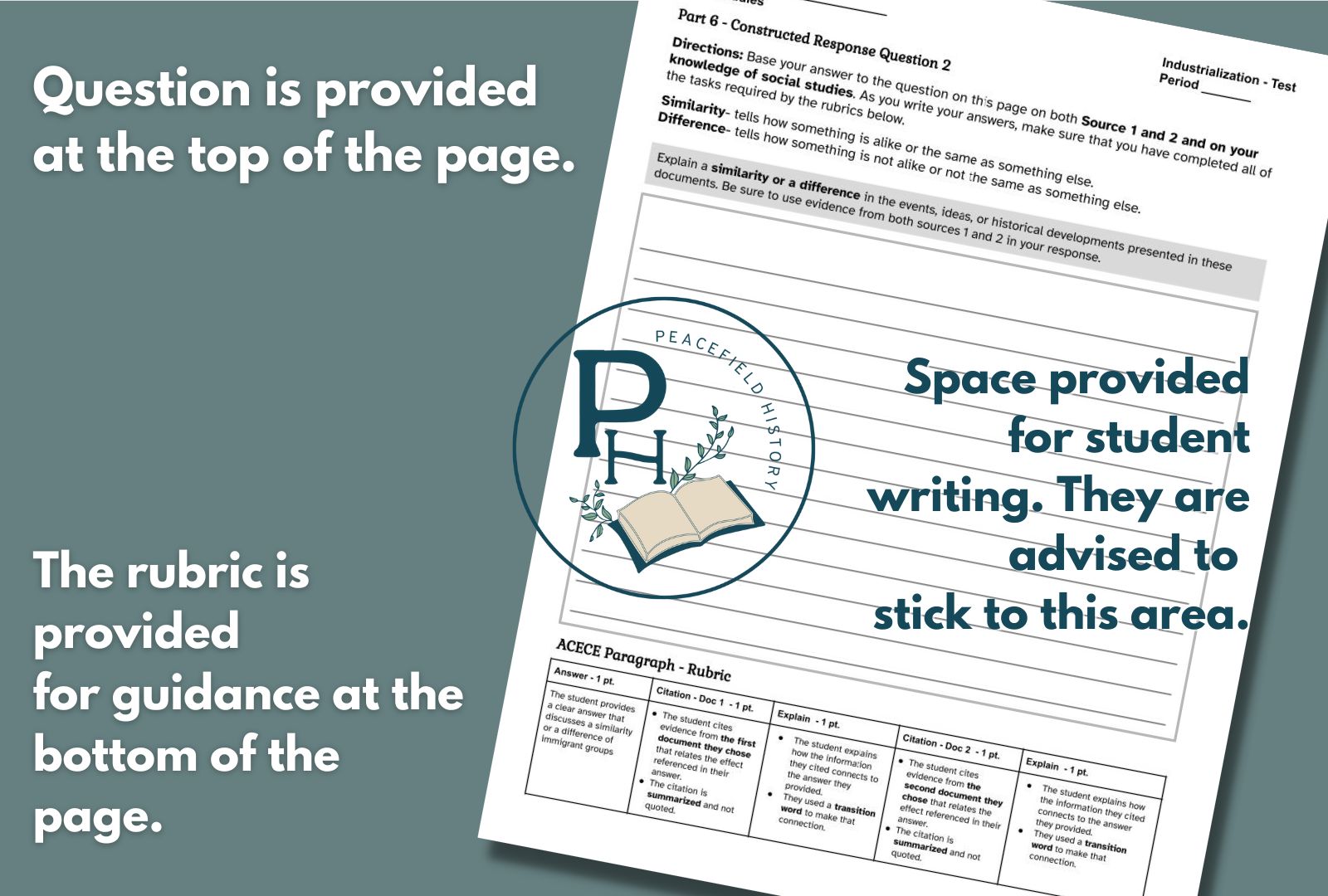
Today’s blog post addresses a topic that all Social Studies teachers just LOVE thinking about… testing.
I know, I know, I’m just kidding. I know that none of us went into teaching to think about or obsess over testing. However, given that it can make up such a big part of our year, I find that creating an organized system for teaching and scaffolding responses to test questions can both build student skill and actually lead to less discussions about the process during the year.
The most recent iteration of New York State Social Studies Regents exam has turned its attention towards having students write more explicitly with historical thinking and primary source documents in their answers.
Of course, just to make it more complicated, the Global Studies and U.S. History Regents have students address this idea with different questions. As I teach 8th graders in NY, I decided to turn my instruction towards the Global Studies Constructed Response Questions. They will encounter the Global Studies Regents first, and the CRQs on the Global Studies Regents are simpler to write. Therefore, it made sense to tailor my instruction towards that goal.
An Acronym and Rubric for Social Studies CRQs
The key to having students write answers that properly address constructed response questions in Social Studies is an explicitly taught rubric. When I created my CRQ rubric, I decided that I would derive it from the common writing acronym utilized by English teachers in my district (and around the country). RACE is a very common instructional tool to have students write proper paragraphs in English. It stands for the following:
R – Restate (Students are commonly taught to echo the question as an answer.)
A – Answer (obvious, right?)
C – Cite (Students are taught to quote text from a piece of writing to support their answer.)
E – Explain (Students are taught to explain how their quote connects to their answer.)
Modifying the Rubric to Work for Social Studies
While this acronym works quite well in English classes, it doesn’t work for CRQs in Social Studies for a number of reasons. For one, students should be comparing two different documents in their answers. If they’re not told that they need to do so directly, most won’t. Secondly, quoting text doesn’t really help students to show that they understand the text, and beyond that, it doesn’t help them to answer the question in the first place. Finally, at least in NY, the Regents exams questions don’t really work well for restatating. A typical Regents CR question is written as follows:
“Identify and explain a cause-and-effect relationship between the events and/or ideas found in these
documents. Be sure to use evidence from both Documents 1 and 2 in your response.”
Rewriting that as a restate would odd and unnecessary. I have students focus on just answering the question and having their first sentence contain the answer. The rubric I created reflects that train of thought.
A Better Rubric – The ACECE Acronym
What I’ve essentially done is break down the RACE acronym and reframe it as ACECE.
I modify this rubric to match the question contained on each assessment, however, this is the general set up.
(A)NSWER – Students answer the question by discussing whatever the prompt requests. They should use the provided documents to frame their answer.
(C)ITE and (E)XPLAIN – Students should cite evidence from the first document provided and then explain how that piece of evidence connects to the answer given. Students should not quote, but rather summarize the evidence provided. With their explanation, I encourage students to use a transition word to begin their response. It doesn’t always happen, but it’s I see it more as a way to scaffold student writing.
(C)ITE and (E)XPLAIN – Students now cite and and explain evidence from the second document.
Some might notice that I actually require a bit more from students than required by the Regents exam. I don’t see this as a problem. My hope is that students will remember this process and even if they provide a bit less detail in their answers on the Regents (sans rubric), the process will have become so innate that they will still earn credit.

I’ve abbreviated this to an ACECE paragraph. It’s not catchy, but it works!
Teaching and Scaffolding the CRQ
When we start writing CR paragraphs at the beginning of the school year, I also have students work with me at they write them and I provide a formula for them to follow.
ANSWER
- There were many effects of ____________________ including ______________ and ___________
- Similarities/ Differences of the _________________ include _______________ and ___________
- A cause of ____________________ was _____________________ and an effect was __________________.
- A turning point found in the documents was ________________________________ and it created significant change by _______________________.
CITE and EXPLAIN –
As students become more adept, I pull away from this formula, and allow students more flexibility in their responses. They must always follow the rubric, but they are allowed to reorder and reorganize their answer.
As I introduce new types of questions and increase the complexity of those questions, I often provide an example within the unit of study. CRQs are easy to fit in as part of class instruction and I can easily add one to sum up a lesson. Sometimes, I don’t have students use document directly. Instead, they might use details from the lesson that day or they might independently research an “effect” of a particular event.
Scaffolding Assessments
With my first assessment of the school year, I provide more specific questions for students to structure their answer. My first test only asks questions like the following:
- How does the document provided above represent a cause of conflict in the west?
- How does the document provided above represent an effect of immigration?
As students become more proficient in answering these types of questions, I build in more complexity.
- Do these two documents reflect a similarity or a difference in points of view regarding imperialism?
- How do these documents reflect a cause and an effect of World War I?
By the end of the school year, I’ll just provide them the generic wording of the Regents and require them to figure it out themselves.
I’ve been gradually updating my assessments to include two CRQs on each version of the tests. Each CRQ also includes documents that fit with the question. I now have updated assessments for my units on the West, Industrialization, Imperialism, and the Great Depression. Assessments for World War I, the Roaring Twenties, and World War II are forthcoming. You can find all of them here – Assessment for Social Studies.

2 Responses
Hi! Great post! Do you have stand alone document template w/the ACECE rubric in your TpT store?
No, I don’t. Sorry! I planned on putting one together, but I haven’t had the chance yet. I’m hoping to send one out soon (likely a freebie).